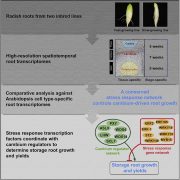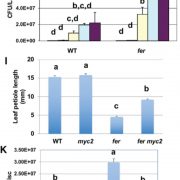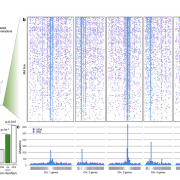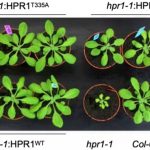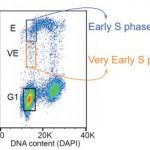It takes two to tango: two GNOMs have to activate ARF1 together
Brumm et al. investigate how the protein GNOM activates dimers of the small GTPase ARF1 and inserts them very close to each other during vesicle formation. The Plant Cell (2020) https://doi.org/10.1105/tpc.20.00240
By Sabine Brumm 1,2 and Gerd Jürgens 1, ZMBP, University of Tübingen (1), Sainsbury Laboratory, University of Cambridge (2)
Background: Eukaryotic cells deliver one out of every three proteins to their sites of action (and degradation) in membrane-bound carriers called vesicles. Their trafficking within the confines of the cell is regulated during the vesicle formation – where it forms, which proteins get in and where the vesicle goes. A major regulator for the initiation of vesicle formation is a small GTPase named ARF, which acts as a molecular switch, and its activator guanine-nucleotide exchange factor (GEF, or ARF-GEF). Inactive ARFs are soluble, whereas active ARFs reside on intracellular membranes, where they recruit coatomer coat proteins required for vesicle formation and cargo selection. All ARF-GEFs have a catalytic domain that on their own can mediate guanine-nucleotide exchange on ARF in a test tube. In the cell, however, ARF-GEFs form homodimers, that is a complex of two identical subunits.
Question: Why do Arabidopsis ARF-GEF proteins exist as dimers of identical subunits, each able to activate one ARF1 molecule? Is there some coordination during ARF1 activation, what is its consequence and what happens if coordinated activation fails? We focused here on the ARF-GEF GNOM.
Findings: We showed that GNOM always exists as a dimer, whether or not they are activating ARF1. One GNOM interacts with two ARF1 molecules at the membrane at the same time, as shown by blocking the exchange reaction. As a consequence of coordinated activation, ARF1 proteins are inserted into the membrane next to each other, only 10 nm or less apart. Genetic inactivation of ARF1 strongly impaired vesicle trafficking. Similarly, mutations in GNOM that reduce the coordinated activation of two ARF1 molecules by the two catalytic domains of the ARF-GEF dimer also interfered with vesicle traffic. Thus, coordinated activation of two ARF1 GTPases results in their close spacing in the vesicle-forming membrane and appears essential for membrane traffic.
Next steps: Different members of the Arabidopsis ARF-GEF family share ARF1 as their common substrate, although they regulate different trafficking pathways. In the future, we wish to analyze if dimerization of other ARF-GEFs is involved in their subcellular localization and contributes to the specification of trafficking pathways.
Sabine Brumm et al. (2020). Coordinated Activation of ARF1 GTPases by ARF-GEF GNOM Dimers Is Essential for Vesicle Trafficking in Arabidopsis. Plant Cell DOI: https://doi.org/10.1105/tpc.20.00240




